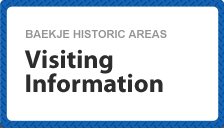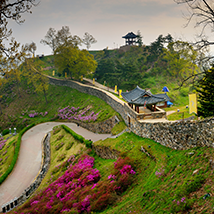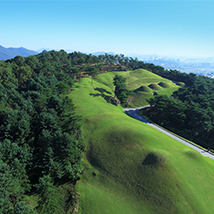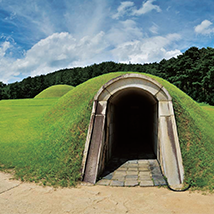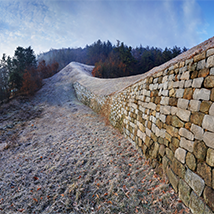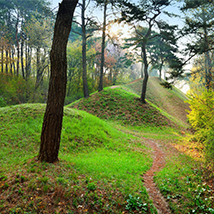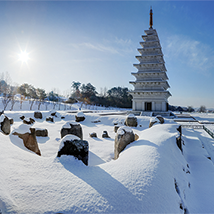
Course

Introduce
-
Gongsanseong Fortress
Built to make the most of the geographical features of the area around the Geumgang River, Gongsanseong Fortress housed the royal palace of Baekje during the Ungjin Period (475-538). The excavations led to the discovery of remains of royal palace buildings, ancillary structures of the palace, and various defensive facilities including earthen walls.
-
Royal Tombs in Songsan-ri
This tomb complex in Songsan-ri, Gongju consists of seven Baekje royal tombs dating from the Ungjin Period. However, the Tomb of King Muryeong has been left untouched by looters and preserved in its original condition, allowing archaeologists to determine when (525) and for whom it was built.
-
Hanok Village
The traditional architecture of Korea is well-known for its beautiful and natural-looking lines and curves of the roof. The ridges of the roofs display natural curves like that of hanging rope, while hip and gable ridges with upward curves on the tips are reminiscent of beautiful beoseon, or traditional socks. There is a collection of hanok houses for group visitors such as family visitors, and the buildings will leave the visitors enraptured with the beauty of traditional architecture.
The paper-covered lattice windows and doors of the hanok buildings in Gongju Hanok Village display the traditional styles celebrated for their classical beauty and elegance. The vintage furniture inside the houses match well with other interior elements for a harmonious appearance. -
Royal Tombs in Neungsan-ri
The Baekje tombs clustered in Neungsan-ri outside Naseong City Wall display a unique difference from the royal tombs of the earlier period, which had usually been built at the center of the capital in order to highlight the royal authority. Most of these tombs had been looted before excavation, but archaeologists nevertheless discovered a stone sarira reliquary and a gilt-bronze incense burner made in 567 at a temple site to the west of the tomb complex.
-
Naseong City Wall
Sabi (present-day Buyeo), the last capital of Baekje, was protected by the Geumgang River, which served as a natural moat protecting it on three sides, north, west, and south. The capital also had a wall called Naseong as a defense structure constructed in the east and this wall is now widely regarded as one of the earliest examples in East Asia of a structure built far outside a city to serve not only as a defense structure but also as a symbolic boundary between its interior and exterior.
-
Jeongnimsa Temple Site
Originally located at the very center of the fortified city of Sabi, Baekje’s last capital, Jeongnimsa Temple is now regarded as one of the earliest Buddhist temples to have been built at the heart of a capital city in East Asia. Excavations have revealed that the temple was once a complex of religious buildings, including a prayer hall, a lecture hall, and monks’ dormitories, exhibiting Baekje’s unique architectural style and symbolizing the Three Jewels of Buddhism, namely, Buddha, Dharma, and Sangha. The site still contains an 8.3-meter-tall stone pagoda in the architectural style of wooden pagodas from the earlier period.
-
Baekje Cultural Heritage Complex
Since Baekje’s capital Buyeo was designated the special region for Baekje culture in 1993, this complex was prepared over 17 years from 1994 to 2010. It has Korea’s first reproduction of Baekje palace during the period of the Three States. Beam on the pillar structure of palace and temple, and the graceful and elegant dancheong are the representative construction style of Baekje. Realistic reproduction of buildings in Sabi based on artifacts and historical sites will help understanding the culture and history of Baekje. Not only Baekje Historical Cultural Center, but also Sabi palace and the famous temple Neungsa, residential culture village that shows the housing culture of each class, the initial royal palace Wiryeseong, and tombs display the life of Baekje, the great cultural country 1,400 years ago.
-
Archaeological Site in Gwanbuk-ri and Busosanseong Fortress
In the archaeological site in Gwanbuk-ri and Busosanseong Fortress related with Baekje in the Sabi Period (538-660), archaeologists discovered the remains of large buildings that once formed part of the royal palace of the kingdom, along with an elaborate rammed-earth wall. They also confirmed that Busosanseong Fortress was used as a shelter by Baekje royalty and their government in times of emergency
-
Mireuksa Temple Site
Widely regarded as one of the largest Buddhist temples in East Asia at the time of its construction, Mireuksa Temple represents the unique tradition of Baekje Buddhism, in which the worship of Maitreya, who is said to have descended from heaven to save all sentient beings through three sermons, played a prominent part. The temple’s architectural layout is characterized by three prayer halls with three pagodas.
-
Archaeological Site in Wanggung-ri
The Archaeological Site in Wanggung-ri was built as a secondary palace by the royal court of Baekje in an attempt to make up for the weakness of the capital city in Sabi (present-day Buyeo). Excavations of the site revealed the traces of various facilities related with the royal palace, which appear to have been set up in a rectangular palace wall, along with buildings related with state ceremonies and political affairs located to its south and a rear garden to its north.

Tel: +82-42-488-9728 / Fax: +82-42-488-6817 / Contact Us: misol.do.88@gmail.com
COPYRIGHT(c) 2017 Baekje World Heritage Center. ALL RIGHTS RESERVED.






